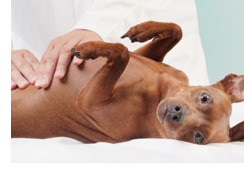
When the stomach is filled with gas, food, liquid or a combination the stomach can sometimes become abnormally enlarged or distended. Abnormal positioning of the stomach which is caused by the stomach’s rotation around its axis, ie, the twisting of the stomach or BLOAT in pets, is a painful condition that is dangerous, life-threatening and requires surgery to repair.
WHAT CAUSES BLOAT?
So far, science and research cannot confirm any one factor that leads to bloat in pets. Therefore, a number of contributing factors are considered to cause this painful condition. One factor includes the feeding of certain food types (onions, peas, beans, beet pulp etc). Another suggests that swallowing too much air without anywhere for it to escape from is a big cause of bloat. Recently, research points to an abnormality in the movement of the stomach relating to electrical impulses.
While the cause of bloat is not completely understood, there are patterns in the types of dogs that it appears in. Larger dogs with deeper chests are more susceptible to the condition, but it is still not unheard of in smaller breeds and even cats.
MANAGEMENT AND PREVENTION
There are no sure fire ways to prevent or predict GDV, however below is a list of the best suggestions available for pet owners:
- Feed 2 or 3 smaller meals daily (as opposed to 1 one large meal) spacing them well apart.
- Any changes in the diet should be made gradually – over a period of a week.
- Vigorous exercise, excitement and stress should be avoided from one hour before to two hours after meals.
- Excessive drinking should also be avoided.
- Avoid feeding foods that are known to cause flatulence (gas) e.g. soy beans, peas, onions beet pulp etc. (check contents of commercial diets especially dry foods)
- Some Vets advocate feeding fresh (raw) fruits and vegies as the fibre content is believed to assist normal stomach function.
- If feeding dry food ensure it is well soaked (20mins) prior to feeding to avoid expansion in the stomach.
- Put both water and feed bowls on a stand at head height – thus reducing the amount of air that is swallowed during eating and drinking.
- If you have more than one dog and meal times are a competition to see who eats the fastest then try feeding them in separate rooms.
- If your dog has a tendency to gulp food try placing a large object in the center of the bowl or investing in a slow feeder.
DIET
Diets which may be of benefit to dogs prone to GDV include Hills i/d and the Big Dog BARF diets. A home-made diet can be formulated reasonably easily if the owner has the time. Raw food is often better than cooked.
For any more questions regarding bloat please contact Pet Doctors Palm Beach on 5576 0400.
Find more interesting articles and Pet Doctors news on our Facebook and Instagram pages
If you would like to make a booking with us you can now book online!

